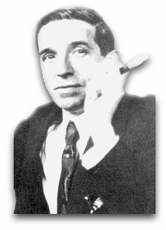|
Ponzi Schemes Named for Charles K. Ponzi, a small-time hustler who hatched a big-time fraud when he claimed astounding return rates on investments within 45 days. When the scheme started to pay the initial investors that actual return, word spread like wildfire and everybody wanted a piece of the action. But it was all a massive, complete put-on, and by the time it was over, 10,000 people had invested $9,500,000 in a con game, and Ponzi had gone from lauded financial genius to incarcerated felon.
Named for Charles K. Ponzi, a small-time hustler who hatched a big-time fraud when he claimed astounding return rates on investments within 45 days. When the scheme started to pay the initial investors that actual return, word spread like wildfire and everybody wanted a piece of the action. But it was all a massive, complete put-on, and by the time it was over, 10,000 people had invested $9,500,000 in a con game, and Ponzi had gone from lauded financial genius to incarcerated felon.
Throughout the entire adventure, one fact is clear: Ponzi was one self-assured motherfucker. Never seen without a snappy suit and stylish straw hat, he smiled, waved his arms, and charmed a room with a quality that made everyone who met him hold their money over their heads and wave wildly. He was just that kind of guy, the guy who you knew would never do you wrong... well, until he did. At his trial, Ponzi was said to constantly smile and chuckle to himself as if enjoying a private joke, and burst out laughing on several occasions as compatriots and ex-staff talked about how completely false his "Securites Exchange Company" had been. In case you suddenly feel the need to try one of these yourself, let's go over how it was done in as few words as possible. Ponzi offered investors an amazing return based on the speculative market of Postal Reply Coupons. Ponzi himself described it this way:
I wrote a man in Spain regarding the proposed magazine and in reply received an international exchange coupon which I was to exchange for American postage stamps with which to send a copy of the publication. The coupon in Spain cost the equivalent of about one cent in American money, I got six cents in stamps for the coupon here. Then I investigated the rates of exchange in other countries. I tried it in a small way first. It worked. The first month $1,000 became $15,000. I began letting in my friends. First I accepted deposits on my note, payable in ninety days, for $150 for each $100 received. Though promised in ninety days I have been paying in forty-five days (N.Y. Times, July 30, 1920) Except for the part where he's lying, the idea sounds completely plausible. Coupons bought for one amount sold for a higher amount. This is basically how speculation in money exchange works: buy a UK pound at $1.67 american, and sell it at $1.87 american, net profit $.20 on the dollar. But it takes time, is not an easy game to play, and profit is not always guaranteed. Ponzi's scheme, however, claimed it was profitable, dependable, and guaranteed. And so the money started coming in. Ponzi initially promised a 50 percent return of investment within 45 days, and 100 percent within 90. This increased to 100 percent within 45 days, which fueled the fire even more. How did the initial investors make their money back? Well, Ponzi was simply taking the money from more recent investors and using it to pay back previous investors. As word spread of the successful return rates, more and more people would be willing to invest, and people who had invested would happily plow their "earnings" back in, meaning enough money was still real to allow Ponzi to continue the fraud. Ponzi's biggest initial problem was that the sheer volume of incoming cash (literally wheelbarrows) caused him to have to start storing his money somewhere other than the office, and so he brought in the Hanover Trust Company, which was as happy to perpetuate the fraud as he was. When the first cracks started showing in Ponzi's pyramid (an overdraft at the bank), he took the entire bank with him. Regulators seized the remaining deposit ($1.5 million) to pay back defrauded investors, but it was too little, too late. The bubble had burst, the money was gone, and Ponzi was on his way to prison. Of course, it came out a tad too late that Ponzi had served time before, for forgery and illegal smuggling, and after serving time for the Ponzi scheme he went to prison for a Florida Land Scheme of equal chutzpah. Deported to Italy after this third prison term, he emigrated to Brazil where he died in a charity hospital, his $75 estate used to bury him. |